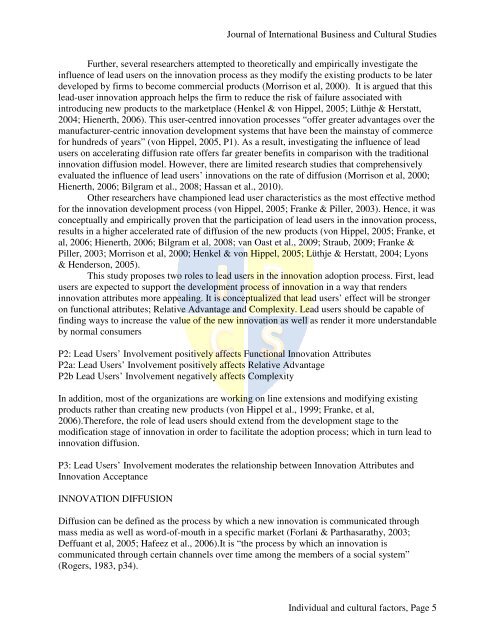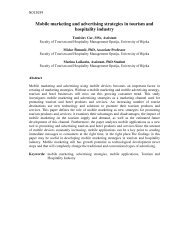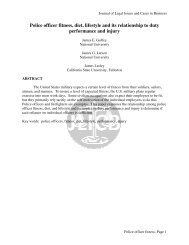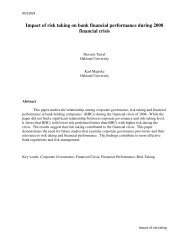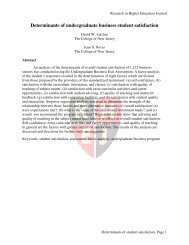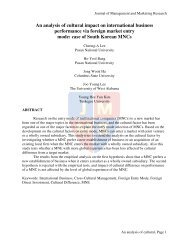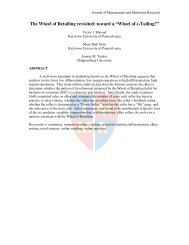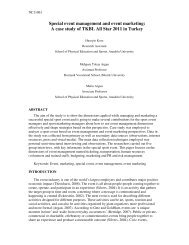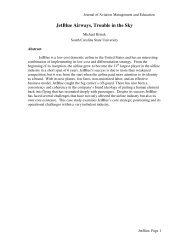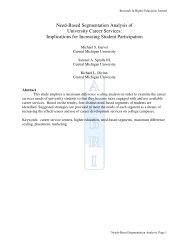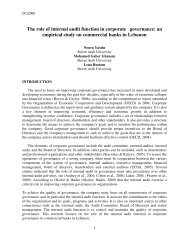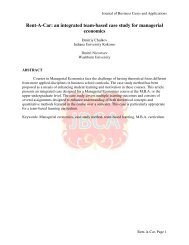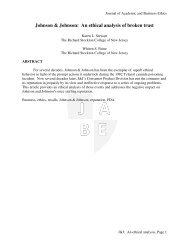Individual and cultural factors affecting diffusion of innovation
Individual and cultural factors affecting diffusion of innovation
Individual and cultural factors affecting diffusion of innovation
You also want an ePaper? Increase the reach of your titles
YUMPU automatically turns print PDFs into web optimized ePapers that Google loves.
Journal <strong>of</strong> International Business <strong>and</strong> Cultural Studies<br />
Further, several researchers attempted to theoretically <strong>and</strong> empirically investigate the<br />
influence <strong>of</strong> lead users on the <strong>innovation</strong> process as they modify the existing products to be later<br />
developed by firms to become commercial products (Morrison et al, 2000). It is argued that this<br />
lead-user <strong>innovation</strong> approach helps the firm to reduce the risk <strong>of</strong> failure associated with<br />
introducing new products to the marketplace (Henkel & von Hippel, 2005; Lüthje & Herstatt,<br />
2004; Hienerth, 2006). This user-centred <strong>innovation</strong> processes “<strong>of</strong>fer greater advantages over the<br />
manufacturer-centric <strong>innovation</strong> development systems that have been the mainstay <strong>of</strong> commerce<br />
for hundreds <strong>of</strong> years” (von Hippel, 2005, P1). As a result, investigating the influence <strong>of</strong> lead<br />
users on accelerating <strong>diffusion</strong> rate <strong>of</strong>fers far greater benefits in comparison with the traditional<br />
<strong>innovation</strong> <strong>diffusion</strong> model. However, there are limited research studies that comprehensively<br />
evaluated the influence <strong>of</strong> lead users’ <strong>innovation</strong>s on the rate <strong>of</strong> <strong>diffusion</strong> (Morrison et al, 2000;<br />
Hienerth, 2006; Bilgram et al., 2008; Hassan et al., 2010).<br />
Other researchers have championed lead user characteristics as the most effective method<br />
for the <strong>innovation</strong> development process (von Hippel, 2005; Franke & Piller, 2003). Hence, it was<br />
conceptually <strong>and</strong> empirically proven that the participation <strong>of</strong> lead users in the <strong>innovation</strong> process,<br />
results in a higher accelerated rate <strong>of</strong> <strong>diffusion</strong> <strong>of</strong> the new products (von Hippel, 2005; Franke, et<br />
al, 2006; Hienerth, 2006; Bilgram et al, 2008; van Oast et al., 2009; Straub, 2009; Franke &<br />
Piller, 2003; Morrison et al, 2000; Henkel & von Hippel, 2005; Lüthje & Herstatt, 2004; Lyons<br />
& Henderson, 2005).<br />
This study proposes two roles to lead users in the <strong>innovation</strong> adoption process. First, lead<br />
users are expected to support the development process <strong>of</strong> <strong>innovation</strong> in a way that renders<br />
<strong>innovation</strong> attributes more appealing. It is conceptualized that lead users’ effect will be stronger<br />
on functional attributes; Relative Advantage <strong>and</strong> Complexity. Lead users should be capable <strong>of</strong><br />
finding ways to increase the value <strong>of</strong> the new <strong>innovation</strong> as well as render it more underst<strong>and</strong>able<br />
by normal consumers<br />
P2: Lead Users’ Involvement positively affects Functional Innovation Attributes<br />
P2a: Lead Users’ Involvement positively affects Relative Advantage<br />
P2b Lead Users’ Involvement negatively affects Complexity<br />
In addition, most <strong>of</strong> the organizations are working on line extensions <strong>and</strong> modifying existing<br />
products rather than creating new products (von Hippel et al., 1999; Franke, et al,<br />
2006).Therefore, the role <strong>of</strong> lead users should extend from the development stage to the<br />
modification stage <strong>of</strong> <strong>innovation</strong> in order to facilitate the adoption process; which in turn lead to<br />
<strong>innovation</strong> <strong>diffusion</strong>.<br />
P3: Lead Users’ Involvement moderates the relationship between Innovation Attributes <strong>and</strong><br />
Innovation Acceptance<br />
INNOVATION DIFFUSION<br />
Diffusion can be defined as the process by which a new <strong>innovation</strong> is communicated through<br />
mass media as well as word-<strong>of</strong>-mouth in a specific market (Forlani & Parthasarathy, 2003;<br />
Deffuant et al, 2005; Hafeez et al., 2006).It is “the process by which an <strong>innovation</strong> is<br />
communicated through certain channels over time among the members <strong>of</strong> a social system”<br />
(Rogers, 1983, p34).<br />
<strong>Individual</strong> <strong>and</strong> <strong>cultural</strong> <strong>factors</strong>, Page 5


